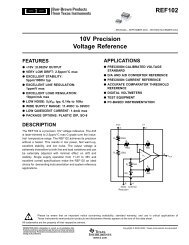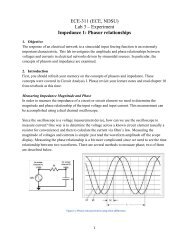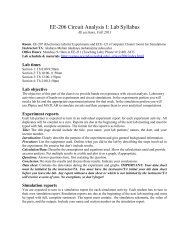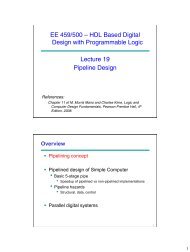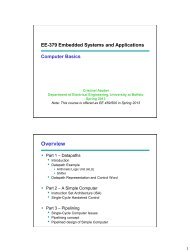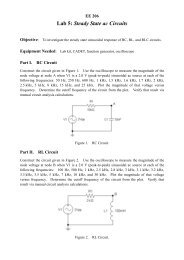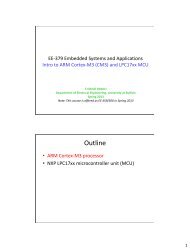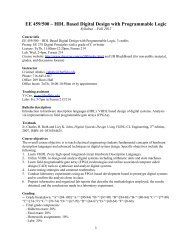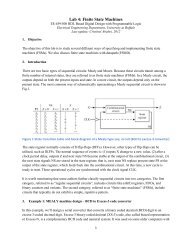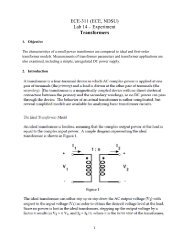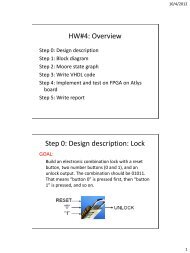Packages, libraries, testbenches, VHDL coding for synthesis
Packages, libraries, testbenches, VHDL coding for synthesis
Packages, libraries, testbenches, VHDL coding for synthesis
You also want an ePaper? Increase the reach of your titles
YUMPU automatically turns print PDFs into web optimized ePapers that Google loves.
EE 459/500 – HDL Based Digital<br />
Design with Programmable Logic<br />
Lecture 8<br />
<strong>Packages</strong> and Libraries<br />
Read be<strong>for</strong>e class:<br />
Chapter 2 from textbook<br />
Overview<br />
• <strong>Packages</strong><br />
• Libraries<br />
• Testbenches<br />
• Writing <strong>VHDL</strong> code <strong>for</strong> <strong>synthesis</strong><br />
1
<strong>VHDL</strong> Structural Elements<br />
• Entity: description of interface consisting of the port list.<br />
• The primary hardware abstraction in <strong>VHDL</strong>, analogous to a symbol in a<br />
block diagram.<br />
• Architecture: description of the function of the corresponding module.<br />
• Process: allows <strong>for</strong> a sequential execution of the assignments<br />
• Configuration: used <strong>for</strong> simulation purposes.<br />
• Package: hold the definition of commonly used data types, constants<br />
and subprograms.<br />
• Library: the logical name of a collection of compiled <strong>VHDL</strong> units<br />
(object code).<br />
• Mapped by the simulation or <strong>synthesis</strong> tools.<br />
<strong>Packages</strong> Declaration<br />
• Collection of definitions of constants, data<br />
types, components, and subprograms.<br />
• A package serves as a central repository<br />
<strong>for</strong> frequently used utilities, such as<br />
component declarations.<br />
• The declarations may then be reused by<br />
any <strong>VHDL</strong> model by simply accessing the<br />
package.<br />
• use WORK.PROJECT_PACK.all;<br />
• The architecture accesses the component<br />
declarations in the package “PROJECT_PACK"<br />
located in the library WORK via the use clause.<br />
• Use clause placed just be<strong>for</strong>e the architecture<br />
body statement.<br />
2
Example<br />
package EXAMPLE_PACK is<br />
type SUMMER is (JUN, JUL, AUG);<br />
component D_FLIP_FLOP<br />
port ( D, CK : in BIT;<br />
Q, QBAR : out BIT);<br />
end component;<br />
constant PIN2PIN_DELAY : TIME := 125ns;<br />
function INT2BIT_VEC (INT_VALUE : INTEGER)<br />
return BIT_VECTOR;<br />
end EXAMPLE_PACK<br />
library DESIGN_LIB;<br />
-- library clause<br />
use DESIGN_LIB.EXAMPLE_PACK.all; -- use clause<br />
entity EXAM is ...<br />
Package Body<br />
• Package body is used to store the definitions of<br />
functions and procedures that were declared in<br />
the corresponding package declaration.<br />
• A package body is always associated with a<br />
package declaration.<br />
• Example:<br />
package body EXAMPLE_PACK is<br />
function INT2BIT_VEC (INT_VALUE: INTEGER)<br />
return BIT_VECTOR is<br />
begin<br />
-- behavior of function described here<br />
end INT2BIT_VEC;<br />
end EXAMPLE_PACK;<br />
3
Example of Package<br />
package LOGIC_OPS is -- package<br />
-- Declare logic operators<br />
component AND2_OP<br />
port (A, B : in BIT;<br />
Z : out BIT);<br />
end component;<br />
component OR3_OP<br />
port (A, B, C : in BIT;<br />
Z : out BIT);<br />
end component;<br />
component NOT_OP<br />
port (A : in BIT;<br />
A_BAR : out BIT);<br />
end component;<br />
end LOGIC_OPS;<br />
Example of Package Usage<br />
-- entity declaration<br />
entity MAJORITY is<br />
port ( A_IN, B_IN, C_IN : in BIT;<br />
Z_OUT : out BIT);<br />
end MAJORITY;<br />
-- architecture description<br />
-- uses components from package LOGIC_OPS in library WORK<br />
use WORK.LOGIC_OPS.all;<br />
architecture STRUCTURE of MAJORITY is<br />
signal INT1, INT2, INT3 : BIT;<br />
begin<br />
A1: AND2_OP port map (A_IN, B_IN, INT1);<br />
A2: AND2_OP port map (A_IN, C_IN, INT2);<br />
A3: AND2_OP port map (B_IN, C_IN, INT3);<br />
O1: OR3_OP port map (INT1, INT2, INT3, Z_OUT);<br />
end STRUCTURE;<br />
4
Overview<br />
• <strong>Packages</strong><br />
• Libraries<br />
• Testbenches<br />
• Writing <strong>VHDL</strong> code <strong>for</strong> <strong>synthesis</strong><br />
Library<br />
5
Library<br />
• There are two reserved library names always available to<br />
designers.<br />
– WORK: Predefined library<br />
– STD: The STD contains two packages: STANDARD<br />
provides declaration <strong>for</strong> predefined types (real, integers,<br />
Boolean, etc). TEXTIO contains useful subprograms that<br />
enables to per<strong>for</strong>m ASCII file manipulations<br />
• library STD; -- declares STD to be a library<br />
• use STD.STANDARD.all; -- use all declarations in package<br />
-- STANDARD, such as BIT, located<br />
-- within the library STD<br />
• A library clause declares WORK to be a library.<br />
library WORK; -- WORK is predefined library<br />
Library<br />
• User-defined <strong>libraries</strong>: LOGIC_LIB<br />
– Assume the LOGIC_OPS package is located in the<br />
LOGIC_LIB library instead of WORK library.<br />
library LOGIC_LIB;<br />
use LOGIC_LIB.LOGIC_OPS.all;<br />
architecture STRUCTURE of MAJORITY is<br />
-- use components in package LOGIC_OPS of library<br />
LOGIC_LIB<br />
6
Overview<br />
• <strong>Packages</strong><br />
• Libraries<br />
• Testbenches<br />
• Writing <strong>VHDL</strong> code <strong>for</strong> <strong>synthesis</strong><br />
Testbench<br />
• Used to verify the specified functionality of a<br />
design<br />
• Provides the stimuli (test vectors) <strong>for</strong> the Unit Under<br />
Test (UUT), analyzes the UUT’s response or stores<br />
the values in a file.<br />
• Simulation tools visualize signals by means of a<br />
wave<strong>for</strong>m which the designer compares with the<br />
expected response. Debug if does not match.<br />
• Does not need to be synthesizable<br />
• No ports to the outside, self-contained<br />
7
Testbench<br />
Testbench<br />
• Simple testbench responses can be analyzed<br />
by wave<strong>for</strong>m inspection<br />
• Sophisticated <strong>testbenches</strong> may require more<br />
complicated verification techniques<br />
• Can take >50% of project resources<br />
• Do not underestimate the value/importance of<br />
<strong>testbenches</strong>!<br />
8
Structure of a <strong>VHDL</strong> Testbench<br />
entity TB_TEST is<br />
end TB_TEST;<br />
architecture BEH of TB_TEST is<br />
-- component declaration of UUT<br />
-- internal signal definition<br />
begin<br />
-- component instantiation of UUT<br />
-- clock and stimuli generation<br />
wait <strong>for</strong> 100 ns;<br />
A
Configuration<br />
• A <strong>VHDL</strong> description may consist of many design entities,<br />
each with several architectures, and organized into a<br />
design hierarchy. The configuration does the job of<br />
specifying the exact set of entities and architectures used in<br />
a particular simulation or <strong>synthesis</strong> run.<br />
• A configuration does two things:<br />
1) A configuration specifies the design entity used in place of each<br />
component instance (i.e., it plugs the chip into the chip socket and<br />
then the socket-chip assembly into the PCB).<br />
2) A configuration specifies the architecture to be used <strong>for</strong> each<br />
design entity (i.e., which die).<br />
Configuration<br />
• A configuration statement is used to bind a component<br />
instance to an entity-architecture pair. A configuration can<br />
be considered as a parts list <strong>for</strong> a design. It describes<br />
which behavior to use <strong>for</strong> each entity, much like a parts list<br />
describes which part to use <strong>for</strong> each part in the design.<br />
• Component configuration can be per<strong>for</strong>med outside the<br />
architecture body which instantiates a certain component.<br />
• A configuration declaration is a design unit which can be<br />
compiled separately.<br />
• The particular architecture body has not to be recompiled<br />
when the binding is changed.<br />
• See detailed discussion in Appendix B.<br />
10
Example<br />
use WORK.all;<br />
architecture PARITY_STRUCTURAL of PARITY is<br />
component XOR_GATE --component declaration<br />
port(X,Y: in BIT; Z: out BIT);<br />
end component;<br />
component INV --component declaration<br />
port(X: in BIT; Z: out BIT);<br />
end component;<br />
signal T1, T2, T3: BIT;<br />
begin<br />
XOR1: XOR_GATE port map (V(0), V(1), T1);<br />
XOR2: XOR_GATE port map (V(2), V(3), T2);<br />
XOR3: XOR_GATE port map (T1, T2, T3);<br />
INV1: INV port map (T3, EVEN);<br />
end PARITY_STRUCTURAL;<br />
use WORK.all;<br />
configuration CONFIG_1 of PARITY is<br />
<strong>for</strong> PARITY_STRUCTURAL<br />
<strong>for</strong> XOR1,XOR2:XOR_GATE use<br />
entity XOR_GATE(ARCH_XOR_1);<br />
end <strong>for</strong>;<br />
<strong>for</strong> XOR3:XOR_GATE use<br />
entity XOR_GATE(ARCH_XOR_2);<br />
end <strong>for</strong>;<br />
<strong>for</strong> INV1:INV use<br />
entity INV(ARCH_INV_1);<br />
end <strong>for</strong>;<br />
end <strong>for</strong>;<br />
end CONFIG_1;<br />
Overview<br />
• <strong>Packages</strong><br />
• Libraries<br />
• Testbenches<br />
• Writing <strong>VHDL</strong> code <strong>for</strong> <strong>synthesis</strong><br />
11
How to write good <strong>VHDL</strong> code with Synthesis<br />
in mind?<br />
• Constraints<br />
• Speed<br />
• Area<br />
• Power<br />
• Macrocells<br />
• Adder<br />
• Comparator<br />
• Bus interface<br />
• Optimizations<br />
• Boolean: mathematical<br />
• Gate: technological<br />
• The optimization phase requires quite a lot of iterations<br />
be<strong>for</strong>e the software reports its final result.<br />
Synthesis Process in Practice<br />
• In most cases <strong>synthesis</strong> has to be carried out several<br />
times in order to achieve an optimal <strong>synthesis</strong> result<br />
12
Write code <strong>for</strong> Synthesis: Guidelines<br />
• Consider the effects of different <strong>coding</strong> styles on the<br />
inferred hardware structures<br />
• If Then Else vs. Case vs. ...<br />
• Appropriate design partitioning<br />
• Critical paths should not be distributed to several <strong>synthesis</strong><br />
blocks<br />
• Automatic <strong>synthesis</strong> per<strong>for</strong>ms best at module sizes of several<br />
1000 gates<br />
• Different optimization constraints used <strong>for</strong> separate blocks<br />
• High speed parts can be synthesized with very stringent<br />
timing constraints<br />
• Non-critical parts should consume the least amount of<br />
resources (area) possible.<br />
Combinational Process<br />
-- Example: multiplexer<br />
process (A, B, SEL)<br />
begin<br />
if (SEL = '1') then<br />
OUT
Incomplete Assignment<br />
Library IEEE;<br />
use IEEE.Std_Logic_1164.all;<br />
entity INCOMP_IF is<br />
port (A, SEL: in std_logic;<br />
Z: out std_logic);<br />
end INCOMP_IF;<br />
architecture RTL of INCOMP_IF is<br />
begin<br />
process (A, SEL)<br />
begin<br />
if SEL = ‘1’ then<br />
Z
Combinational Logic<br />
architecture EXAMPLE of FEEDBACK is<br />
signal B,X : integer range 0 to 99;<br />
begin<br />
process (X, B)<br />
begin<br />
X
Source Code Optimization<br />
An operation can be described very efficiently <strong>for</strong> <strong>synthesis</strong>:<br />
OUT1
Appendix A: Assignment with Array Types<br />
• Elements are assigned according to their position, not<br />
their number<br />
• The direction of arrays should always be defined the<br />
same way<br />
architecture EXAMPLE of ARRAYS is<br />
signal Z_BUS : bit_vector (3 downto 0);<br />
signal C_BUS : bit_vector (0 to 3);<br />
begin<br />
Z_BUS
Aggregates<br />
architecture EXAMPLE of AGGREGATES is<br />
signal BYTE : bit_vector (7 downto 0);<br />
signal Z_BUS : bit_vector (3 downto 0);<br />
signal A_BIT, B_BIT, C_BIT, D_BIT : bit;<br />
begin<br />
Z_BUS
library IEEE;<br />
Components and port maps<br />
use IEEE.STD_LOGIC_1164.all;<br />
entity MUX2 is entity declaration = chip pins<br />
port (SEL, A, B: in STD_LOGIC;<br />
end;<br />
F : out STD_LOGIC);<br />
architecture declaration = chip die<br />
architecture STRUCTURE of MUX2 is<br />
component INV<br />
port (A: in STD_LOGIC;<br />
F: out STD_LOGIC);<br />
end component;<br />
component AOI<br />
port (A, B, C, D: in STD_LOGIC;<br />
F : out STD_LOGIC);<br />
end component;<br />
signal SELB: STD_LOGIC;<br />
Instantiating components in <strong>VHDL</strong><br />
is like plugging chips into a PCB:<br />
component declaration = chip socket<br />
Port mapping<br />
begin<br />
G1: INV port map (SEL, SELB);<br />
G2: AOI port map (SEL, A, SELB, B, F);<br />
end;<br />
Configuration<br />
Default configuration of MUX2<br />
use WORK.all;<br />
configuration MUX2_default_CFG of MUX2 is<br />
<strong>for</strong> STRUCTURE<br />
-- Components inside STRUCTURE configured by default<br />
-- let's say v2 architecture <strong>for</strong> AOI<br />
end <strong>for</strong>;<br />
end MUX2_default_CFG;<br />
Specified configuration of MUX2<br />
use WORK.all;<br />
configuration MUX2_specified_CFG of MUX2 is<br />
<strong>for</strong> STRUCTURE<br />
<strong>for</strong> G2 : AOI<br />
use entity work.AOI(v1);<br />
-- architecture v1 specified <strong>for</strong> AOI design entity<br />
end <strong>for</strong>;<br />
end <strong>for</strong>;<br />
end MUX2_specified_CFG;<br />
19
Configuration<br />
• Default binding configuration:<br />
• The chip socket (component declaration) carries a chip (design<br />
entity) of the same name (e.g.,, AOI). The chip is inserted into the<br />
socket courtesy of a component instantiation and a configuration<br />
declaration. If configuration is omitted or if we use a default<br />
configuration, the socket and chip must have the same name.<br />
• Specified configuration:<br />
• If we want to choose a particular die (architecture) <strong>for</strong> our chip, we<br />
must specify the architecture in the configuration.<br />
• Late-binding configuration:<br />
• Suppose we want to create a general-purpose socket and at some<br />
later time, we want to specify which chip will be plugged into the<br />
socket. To do this requires a late-binding configuration declaration.<br />
Configuration<br />
Late-binding configuration of MUX2<br />
use WORK.all;<br />
configuration AND4_CFG of MUX2 is<br />
<strong>for</strong> STRUCTURE<br />
<strong>for</strong> G2 : AOI<br />
use entity work.AND4(quick_fix);<br />
-- architecture quick_fix of AND4 specified <strong>for</strong> AOI component<br />
end <strong>for</strong>;<br />
end <strong>for</strong>;<br />
end AND4_CFG;<br />
20




